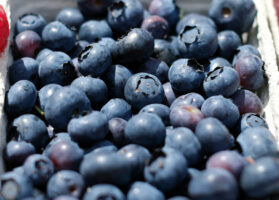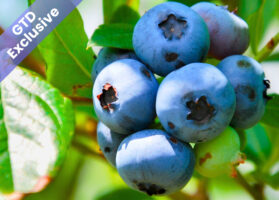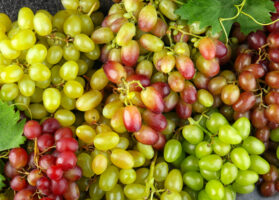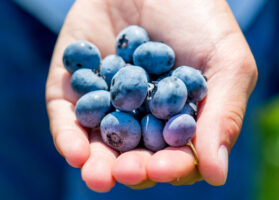California fall fruit preview
Overview of fruits from California in the U.S. market, complemented by charts from Agronometrics. Original published on August 18, 2022.
Summer is winding down and kids are heading back to school. That can only mean one thing: Fall fruit season is almost here.
In California, September’s arrival signals a transition from stone fruits and summer berries to autumn favorites such as pomegranates, persimmons, citrus, kiwi, table grapes and more.

Source: USDA Market News via Agronometrics.
(Agronometrics users can view this chart with live updates here)

Source: USDA Market News via Agronometrics.
(Agronometrics users can view this chart with live updates here)
Ian LeMay, president of the California Fresh Fruit Association, reports that the fall fruit crop looks especially good this year. “It’s sized well and sugars are up,” he says. “From the consumer side, it’s a great year to eat California fruit.”
We checked in with fruit growers to learn more about how this year’s fall crops are shaping up — as well as the challenges the industry is facing — as we head into the autumn season.
Weather and water challenges
Even in sunny California, the weather can present challenges for fruit growers — from hailstorms to a lack of rainfall.
“We definitely had some weather pressures early in the spring,” LeMay says. “Storms came through and we had significant hail that impacted some of the plum acreage. But there is still a solid, marketable crop.”
The bigger issue for California growers, he says, is the state’s ongoing drought, now in its fourth year. Although the state has experienced dry periods in the past, higher temperatures spurred by climate change are exacerbating the situation.
“Our members are definitely wrestling with drought and water availability,” LeMay says. “They are trying to maximize every molecule of water.”
While the drought is not having a significant impact on yield sizes, he adds, the lack of water is causing growers to hesitate before replanting older vineyards and orchards that have been pulled out. To ensure abundant crops for the future, farmers are investing in improved irrigation systems, or working with researchers to identify new fruit varieties that require less water.
“Water continues to be a strained or diminishing resource in California, so you cannot go into a season and think that you’re going to do things the way you did last year,” says LeMay. “You have to adapt every year.”
Stephen Paul, category director for deciduous and blueberry fruits at Homegrown Organics in Porterville, Calif., believes that the lack of water is putting stress on fruit crops and leading to some lighter yields, though it remains to be seen what the long-term impacts will be.
“I think what we’re dealing with is that, over a long period of time, this is causing effects that we’ve never seen before,” he said. “Water levels drop. We become more restrictive with water. We may be putting more stress on the trees as an industry. This is really uncharted territory that we are dealing with. We only know what’s in front of us and what’s behind us.”
Positive outlook for fall favorites
Justin Bedwell, president at Bari Produce in Fresno, Calif., reports that the fall set is looking good across the board. “Pomegranates have nice size and look to be developing four to five days earlier than last year,” he said.
Availability this autumn will include table grapes, pomegranates, persimmons and late yellow peaches.
While Bedwell expects 2022 table grape volumes to be similar to those of 2021, which were down slightly over the previous year, he believes Bari will see an abundant crop for later-season varieties such as Autumn King, Crimson, Autumn Royal and Allison.
The table grape season is now in full swing for Homegrown Organics, and will hit peak production in October.
“Business has actually been very good this year,” said Craig Morris, category director for citrus and grapes. “Our sales are up about 30% over the previous season to date, and pricing is up about 10% overall from prior seasons.”
Yields are consistent with 2021, but down slightly from an average year. However, with new plantings coming on line this year, supply should not be an issue. For green varieties, Homegrown will have Timpson, Great Green and Kelly. Red varieties will include Magenta, Scarlet Royal, Timco and Krissy. “The Brix levels are super high and the grapes have great crunch,” says Morris. “It’s really been a banner year so far.”
By December 1, the company will be in peak production for citrus, including oranges, lemons, Mandarins and grapefruit. “What’s unique about citrus is that, through cultural practices, we can train our trees for when we want harvest to hit,” says Morris. “With a stone fruit or a blueberry, it tells you, ‘You’re going to come get me or I’m going to fall on the ground.’” The ability to let citrus hang on the trees allows growers to control the flow of fruit throughout the season to maintain a consistent supply.
Following a short crop in 2021, he adds, this fall’s citrus yields should be closer to average. “After having such a poor crop last year, down around 35%, it’s great to get back to a normal year,” says Morris. “We’re really excited.”
This fall, Valencia-based Sunkist Growers will harvest a variety of California citrus. “We are excited to offer zesty lemons, juicy Valencia oranges and bursting Marsh Ruby grapefruit through October,” says Christina Ward, senior director of global marketing at Sunkist. Mandarins will return this fall, she adds, along with classic Navel oranges in November.
Paul notes that yields for early varieties of Asian pear look a bit lighter than average, while mid-season and later varieties should see a normal-size crop. Homegrown Organics will have average yields for both Hachiya and Fuyo persimmon varieties, and a light-to-normal kiwi crop.
“I think the pomegranate crop is going to be light to normal, but more on the light side,” he says. “We mainly grow the Wonderful variety, which is what everyone wants.”
Promoting fall fruits
To commemorate Sunkist Growers’ 130th anniversary in 2022, the company is launching bright new packaging for its easy-peel California mandarins, featuring Sunkist’s 1960s lollipop logo. A QR code on store display bins takes shoppers to the “Peel Good Citrus” online destination, which features games, photo filters and citrus-themed activities.
“We know that consumers prefer to shop for produce, particularly oranges, in stores, which indicates the significance of eye-catching designs and merchandising efforts that engage shoppers where they want to buy,” says Ward. “These touch points are especially crucial when kicking off the season.”
To support retail customers this fall, Sunkist will continue its current marketing programs and update merchandising offerings.
“Consumers are increasingly mindful of where their food comes from,” says Ward, “and with multigenerational family farmers making up our citrus cooperative, we are excited to bring their stories to life through digital platforms, merchandising and point-of-purchase.”
At Bari Produce, Bedwell is collaborating with retail partners to create fall ads for its pomegranates and red table grapes. “October is a good month for us to showcase both of them,” he says.
Paul says that, as fall approaches, he would love to see more retailers promote the health benefits of fresh California fruit — especially in light of inflation-based rising prices.
“Individuals have a healthier mindset now,” he says. “Yeah, fruit may be more expensive, but maintaining good health requires good, healthy eating. You’re investing in your body.”
The News in Charts is a collection of stories from the industry complemented by charts from Agronometrics to help better tell their story.
Access the original article with this (Link)






